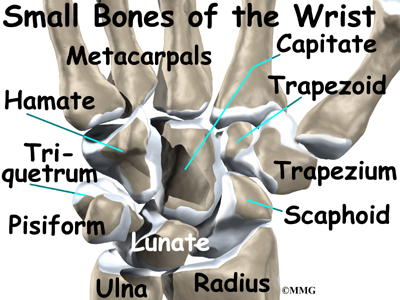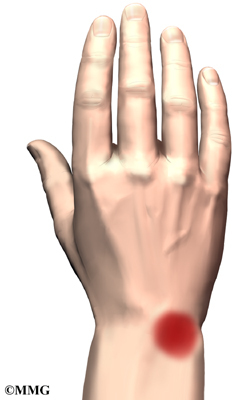Kienbock's disease is a condition in which one of the small
bones of the wrist loses its blood supply and dies, causing pain and stiffness
with wrist motion. In the late stages of the disease, the bone collapses,
shifting the position of other bones in the wrist. This shifting eventually
leads to degenerative changes and osteoarthritis in the joint. While the exact
cause of this uncommon disease isn't known, a number of treatment options are
available.
This guide will help you understand
- how Kienbock's disease develops
- how doctors diagnose the condition
- what treatment options are available
Anatomy
How does the wrist joint work?
The anatomy of the wrist joint is extremely complex,
probably the most complex of all the joints in the body. The wrist is
actually a collection of many joints and bones. These joints and bones let
us use our hands in lots of different ways. The wrist must be extremely
mobile to give our hands a full range of motion. At the same time, the wrist
must provide the strength for heavy gripping.
The wrist is made of eight separate small bones, called
the carpal bones. The lunate is one of these bones.

It is the bone that is affected in
patients with Kienbock's disease.
The carpal bones connect the two bones of
the forearm, the radius and the ulna, to the bones of the hand. The
metacarpal bones are the long bones that lie underneath the palm. The
metacarpals attach to the phalanges, which are the bones in the fingers and
thumb.
Causes
Why do I have this condition?
Doctors have not determined
exactly what causes Kienbock's disease. A number of factors seem to be
involved. Usually the patient has injured the wrist. The injury may be a
single incident, such as a sprain, or a repetitive trauma. But the injury
alone does not seem to cause the disease.
The way that blood vessels
supply the lunate is thought to play a role in Kienbock's disease. Some
bones in the body simply have fewer blood vessels that bring in blood. The
lunate is one of those bones. A bone with a limited blood supply may be more
at risk of developing the disease after an injury. The reduced blood supply
might be the result of a previous injury to the blood vessels.
Other bones around the lunate
may play a role in the disease, too. The length of the ulna, the bone of the
forearm on the opposite side of the thumb, may be a factor. When the ulna is
shorter than the radius, the lunate bone absorbs more force when the wrist
is used for heavy gripping activities. Over time, this extra force may make
it more likely for a person to develop Kienbock's disease. The extra forces
make a person more likely to injure the lunate or the blood vessels around
it as a result.
Kienbock's disease is also
sometimes found in people with other medical conditions that are known to
damage small blood vessels of the body. Whatever the cause, the lunate bone
develops a condition called osteonecrosis.
In osteonecrosis, the bone dies, usually because it's not getting enough
blood.
Symptoms
What does Kienbock's disease
feel like?
The primary symptoms of
Kienbock's disease are pain in the wrist and limited wrist motion. Pain may
vary from slight discomfort to constant pain. In the early stages there may
be pain only during or after heavy activity using the wrist. The pain
usually gets slowly worse over many years. The wrist may swell. The area
over the back of the wrist near the lunate bone may feel tender. You may not
be able to move your wrist as much as normal or grip objects as well.
Patients often have the
condition for months or years before seeking treatment. Typically, the
patient will report an injury to the wrist in the past or have a history of
repetitive heavy use of the wrist. Kienbock's disease most frequently
affects men 20 to 40 years old. It rarely affects both wrists.

Diagnosis
How do doctors identify the problem?
Your doctor will begin by taking a detailed history of the
problem and examining the wrist.
X-rays and possibly a magnetic resonance imaging (MRI)
scan will be ordered. The X-rays are useful to determine how far the disease
has advanced. This helps your doctor plan treatment. The MRI machine uses
magnetic waves instead of radiation to take a series of pictures that look
like slices of the wrist. The MRI scan is most useful if your doctor is not
sure whether the lunate bone has lost its blood supply. The MRI is extremely
accurate at showing whether a bone has a blood supply or not. Changes in the
lunate bone will usually appear on one of these tests. No other tests are
usually required.
Treatment
Acupuncture is to improve blood and qi circulation which
is the dominant change in Kienbock's disease. According to Chinese medicine,
pain is caused by blood/qi stagnation along the meridians. Stimulation of
the acupoints around the affected area will cause the increase of blood
supply and activate the repair process.